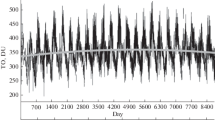Abstract
Measurements at the Tropospheric Ozone Research (TOR) station of Institute of Atmospheric Optics, Siberian Branch, Russian Academy of Sciences, in 1994–2017 are used to study the dependence of variations in ozone concentration in the near-surface air layer on the absolute humidity. We found a neutral dependence at positive temperatures and surprisingly strong and sign-alternating variability at negative temperatures. The absolute air humidity negatively affects the ozone formation in the near-surface air layer, leading to decreased ozone concentration at temperatures of 0 to −30°C. At very low (below −30°C) temperatures the effect becomes positive, i.e., the ozone concentration increases with the absolute humidity.


Similar content being viewed by others
REFERENCES
V. V. Lunin, M. P. Popovich, and S. N. Tkachenko, Physical Chemistry of Ozone (MSU, Moscow, 1998) [in Russian].
B. D. Belan, Tropospheric Ozone (Publishing House of AIO SB RAS, Tomsk, 2010) [in Russian].
P. S. Monks, A. T. Archibald, A. Colette, O. Cooper, M. Coyle, R. Derwent, D. Fowler, C. Granier, K. S. Law, G. E. Mills, D. S. Stevenson, O. Tarasova, V. Thouret, E. von Schneidemesser, R. Sommariva, O. Wild, and M. L. Williams, “Tropospheric ozone and its precursors from the urban to the global scale from air quality to short-lived climate forcer,” Atmos. Chem. Phys. 15 (15), 8889–8973 (2015).
R. Yadav, L. K. Sahu, G. Beig, and S. N. A. Jaaffrey, “Role of long-range transport and local meteorology in seasonal variation of surface ozone and its precursors at an urban site in India,” Atmos. Res. 176–177, 96–107 (2016).
S. S. Gunthe, G. Beig, and L. K. Sahu, “Study of relationship between daily maxima in ozone and temperature in an urban site in India,” Curr. Sci. 110 (10), 1994–1999 (2016).
S. Munir, T. M. Habeebullah, K. Ropkins, and A. R. Seroji, “Modelling ozone-temperature slope under atypically high temperature in arid climatic conditions of Makkah, Saudi Arabia,” Aerosol Air Quality Res 15 (4), 1281–1290 (2015).
D. Jasaitis, V. Vasiliauskien, R. Chadysien, and M. Peciuliene, “Surface ozone concentration and its relationship with UV radiation, meteorological parameters and radon on the eastern coast of the Baltic Sea,” Atmos. 7 (27) (2016).
P. Pavon-Dominguez, F. J. Jimenez-Hornero, and E. Gutierrez De Rave, “Proposal for estimating ground-level ozone concentrations at urban areas based on multivariate statistical methods,” Atmos. Environ. 90, 59–70 (2014).
Y. Y. Toh, S. F. Lim, and R. von Glasow, “The influence of meteorological factors and biomass burning on surface ozone concentrations at Tanah Rata, Malaysia,” Atmos. Environ. 70, 435–446 (2013).
N. V. Tereb, L. I. Milekhin, V. L. Milekhin, V. D. Gnilomedov, D. R. Nechaev, L. K. Kulizhnikova, and V. V. Shirotov, “Surface ozone values in anomalous summer 2010 measured in Obninsk,” Rus. Meteorol. Hydrol. 38 (5), 304–312 (2013).
A. B. Tawfik and A. L. Steiner, “A proposed physical mechanism for ozone-meteorology correlations using land-atmosphere coupling regimes,” Atmos. Environ. 72, 50–59 (2013).
P. J. Crutzen and P. H. Zimmermann, “The changing photochemistry of the troposphere,” Tellus 43 (4), 136–151.
H. Levy II, “Normal atmosphere: Large radical and formaldehyde concentrations predicted,” Science 173 (3992), 141–143 (1971).
D. K. Davydov, B. D. Belan, P. N. Antokhin, O. Yu. Antokhina, V. V. Antonovich, V. G. Arshinova, M. Yu. Arshinov, A. Yu. Akhlyostin, S. B. Belan, N. V. Dudorova, G. A. Ivlev, A. V. Kozlov, D. A. Pestunov, T. M. Rasskazchikova, D. E. Savkin, D. V. Simonenkov, T. K. Sklyadneva, G. N. Tolmachev, A. Z. Fazliev, and A. V. Fofonov, “Monitoring of atmospheric parameters: 25 Years of the Tropospheric Ozone Research Station of the Institute of Atmospheric Optics, Siberian Branch, Russian Academy of Sciences,” Atmos. Oceanic Opt. 32 (2), 180–192 (2019).
B. D. Belan, D. E. Savkin, and G. N. Tolmachev, “Generation of ozone in the surface air layer versus air temperature,” Atmos. Ocean. Opt. 31 (2), 187–196 (2018).
Funding
Air composition is monitored within the State Assignment of Institute of Atmospheric Optics, Siberian Branch, Russian Academy of Sciences; the study was supported by the Russian Foundation for Basic Research (grant no. 17-05-00374).
Author information
Authors and Affiliations
Corresponding authors
Ethics declarations
The authors declare that they have no conflicts of interest.
Additional information
Translated by O. Bazhenov
Rights and permissions
About this article
Cite this article
Belan, B.D., Savkin, D.E. The Role of Air Humidity in Variations in Near-Surface Ozone Concentration. Atmos Ocean Opt 32, 586–589 (2019). https://doi.org/10.1134/S1024856019050038
Received:
Revised:
Accepted:
Published:
Issue Date:
DOI: https://doi.org/10.1134/S1024856019050038




